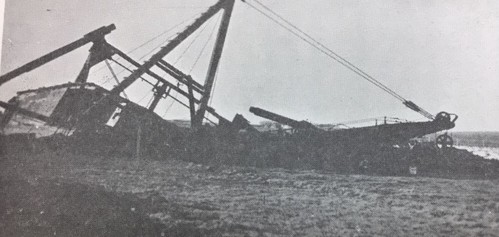Persistent Weather Dangers: Tornado, 1925; Flash Flood 2018
Franklin county, Iowa

When the writers of the Works Progress Administration introduced the story of a tornado near Alexander, in Franklin County, in 1925, they imagined that most weather hazards were no longer a threat to humans—at least those humans with shelter and heat. “The days of natural hazards had passed. No longer did the settlers need to be on the lookout for prairie fires, and snug homes and adequate heating systems thwarted or minimized the intense cold of winter.” But, they surmised, tornadoes were different. They could strike without warning. On the one hand, the warning systems for tornadoes have improved since 1941; on the other hand, weather hazards are not fully controllable or predictable and human responses to warnings vary.
That 1925 tornado in Franklin County was, for sure, a powerful storm that caught many unawares. It came from the southwest and hit Alexander first destroying houses and uprooting trees. Many windows were blown out; two churches were completely demolished. “A train loaded with hogs was blown from the tracks and the cars turned upside down.” Twelve animals lost their lives although no humans did. In the train depot nearby E.S. Packard and his two young sons were thrown to the floor by the force of the wind that took the walls from the building. When the storm passed, the three were alive on the floor with a flurry of office records scattered over them.
Outside town the tornado destroyed many farm buildings, and a number of injuries occurred: head wounds, bruises, a fractured hip, a broken leg. The Harvey Hemme farm was entirely demolished although the family of seven survived in the basement unharmed. Their barn and two horses in harness were drawn up into the twister. The barn did not survive. The horses did but without the harness and with numerous splinters penetrating their skin. 700 chickens on the farm were less fortunate.
Another farm family saw the storm too late to take shelter in their cellar. The house was taken by the storm, and W.J. Evans and his mother, tenants on the farm, were injured. She was hospitalized. The wind plowed furrows in some of the county’s fields and stripped corn of its leaves in others. Damages in the county were estimated at $250,000 (1925 dollars).

In the twenty-first century tornadoes remain a threat, but so do other hazards. Flash floods are among those dangers most prevalent in this century. September 5, 2018, brought a familiar warning of quickly rising waters in Franklin County. “In the past 24 hours, a widespread 2 to 4 inches of rain has fallen across the warned area. Local Emergency Management and Law Enforcement officials have reported several road closures due to water over the roadways.” Those sloughs and wetlands dredged over a century ago can become wetlands again quickly. Among the locations listed as flooded were Hampton, the Hampton Municipal Airport, Coulter, Bradford, Latimer, Alexander, and Beeds Lake State Park. Most local residents will recognize the familiar warning: “Turn around, don’t drown when encountering flooded roads. Most flood deaths occur in vehicles.” Many local residents also know a story of someone who lost his or her life not heeding this warning.
Sources: SHSI: Franklin County History Iowa, Writers’ Program of WPA, 1941; on-line: “Flood Warnings in Effect for Many Counties in Viewing Area,” KIMT3 News, September 5, 2018; History of Latimer, Iowa, 1972.
